 The Sonaide Bri are a human culture that spans countless tiny kingdoms and principalities united by a common culture, beliefs and traditions, religion, and language (before the advent of the Common Tongue about three millennia ago). They worship the Áes Camáir, the Children of Dawn: five gods and their descendants who are directly descended from Camáir, the goddess of Dawn who gave life to the world.
The Sonaide Bri are a human culture that spans countless tiny kingdoms and principalities united by a common culture, beliefs and traditions, religion, and language (before the advent of the Common Tongue about three millennia ago). They worship the Áes Camáir, the Children of Dawn: five gods and their descendants who are directly descended from Camáir, the goddess of Dawn who gave life to the world.
Musicians and artists are revered among the Sonaide Bri, who claim (though the elves in particular dispute this) that the first bard to weave magic through song was a member of the Sonaide Bri.
Sonaide Bri Wars with the Anakim
Once upon a time, generations ago, the various people of Sonaide Bri found themselves attacked by great giants who called themselves the Anakim, progeny of the Nephilim gods of the giants. Though the Sonaide Bri heroes fought valiantly, they were no match against their giant foes.
Then a great mist came rolling from the hills, and from it marched five divine warriors who beat back the Anakim. They called themselves the Áes Camáir, the Children of Dawn, the great goddess Camáir who created everything, and they became the protectors of the Sonaide Bri.
The five Children of Dawn remained with the Sonaide Bri, siring a handful of additional gods through inter-couplings with each other. The Sonaide Bri grew to worship their new gods and depend on them for divine protection.
Sonaide Bri legends have many tales of the Áes Camáir interacting with mortals, but not Camáir herself, who remains removed. Some of the Sonaide Bri’s greatest heroes claim demigod status from being descended from one of the Áes Camáir, while other great mortal heroes, it is said, may be elevated to demigod status through their great deeds.
The Gods of the Áes Camáir
The gods of the Áes Camáir reside in palaces accessed through the mist and fog known as The Féth, the magic mist. The Féth is the gateway from the Áes Camáir’s palaces to Adnati and other realms, but it is also a mode of transport. The Áes Camáir gods can command The Féth to appear anywhere, allowing them to escape any predicament – but also to travel quickly anywhere else when they command The Féth to then open anywhere else they choose.
Five of Áes Camáir gods are the children of Camáir herself. Most have had couplings and even marriages with various beings of lesser power, including mortals, but only one – Ordae Ruíri – has married someone (Rígan Lúan, the Fairy Queen) whose divine power is seen to be equal to that of the Áes Camáir. Their children born of one another all have the full power of the Áes Camáir. But in addition, some have been known to couple with the elemental forces of nature itself and have given birth to other beings of demigod power.
The Creator
 Camáir is the Goddess of Dawn, said to have created the universe. Though legends reference her, they never depict her as directly appearing, unlike her children. She is a patron of all things in her many faces, but most Sonaide Bri clerics pledge their service to one of her children rather than to her directly. She is the mother of five of the gods – Ordae Ruíri, Lir ap Tríath, Brigga ap Ítharnae, Déine ap Gáeth, and Arúyn – and, through them, is the direct ancestor of the other Áes Camáir gods.
Camáir is the Goddess of Dawn, said to have created the universe. Though legends reference her, they never depict her as directly appearing, unlike her children. She is a patron of all things in her many faces, but most Sonaide Bri clerics pledge their service to one of her children rather than to her directly. She is the mother of five of the gods – Ordae Ruíri, Lir ap Tríath, Brigga ap Ítharnae, Déine ap Gáeth, and Arúyn – and, through them, is the direct ancestor of the other Áes Camáir gods.
Primary Gods
Children of Camáir
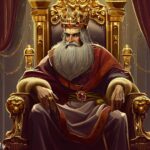 Ordae Ruíri of the Áes Camáir, the eldest of Camáir’s children, is married to Rígan Lúan, though that hasn’t stopped either of them from having affairs and even children with other lovers. He is depicted as a wise, aging warrior king who presides in Tír Tairngiri, a glittering palace of white marble and gold leaf carved into mountainous caves that provide access to the Feywild. He sits upon a stone throne and wears a golden crown, the Lía dé Ordae, one of the four great artifacts known as the Four Blessings. He is the eldest of Camáir’s five children. The Festival of Ordae Ruíri, or Faylon Ordae, begins at sundown on Meludaans 15th and continues into the next evening. It is a midsummer celebration and one of the most important on the Sonaide Bri calendar. Children with Rígan Lúan: Damán Allaid, the Weaver. Children with Déine ap Gáeth, the Snow Queen: Airgdide Gérat, the Silver Knight. Domains: Order, Peace, War, Grave, Twilight
Ordae Ruíri of the Áes Camáir, the eldest of Camáir’s children, is married to Rígan Lúan, though that hasn’t stopped either of them from having affairs and even children with other lovers. He is depicted as a wise, aging warrior king who presides in Tír Tairngiri, a glittering palace of white marble and gold leaf carved into mountainous caves that provide access to the Feywild. He sits upon a stone throne and wears a golden crown, the Lía dé Ordae, one of the four great artifacts known as the Four Blessings. He is the eldest of Camáir’s five children. The Festival of Ordae Ruíri, or Faylon Ordae, begins at sundown on Meludaans 15th and continues into the next evening. It is a midsummer celebration and one of the most important on the Sonaide Bri calendar. Children with Rígan Lúan: Damán Allaid, the Weaver. Children with Déine ap Gáeth, the Snow Queen: Airgdide Gérat, the Silver Knight. Domains: Order, Peace, War, Grave, Twilight
 Lir ap Tríath of the Áes Camáir is the god of oceans, travel, foreign relations and trade. He is the second of Camáir’s five children. The Festival of Lir ap Tríath, or Fayluh Lir, is celebrated on the Summer Solstice on the Common Calendar, beginning at sundown on Altadaans 31 and continuing into the evening of Tuthodaans 1. Children with Rígan Lúan: Énchendach ap Fidbaid. Children with Déine ap Gáeth, the Snow Queen: Bráenna ap Túirenn. Domains: Tempest, Life, Grave, Twilight.
Lir ap Tríath of the Áes Camáir is the god of oceans, travel, foreign relations and trade. He is the second of Camáir’s five children. The Festival of Lir ap Tríath, or Fayluh Lir, is celebrated on the Summer Solstice on the Common Calendar, beginning at sundown on Altadaans 31 and continuing into the evening of Tuthodaans 1. Children with Rígan Lúan: Énchendach ap Fidbaid. Children with Déine ap Gáeth, the Snow Queen: Bráenna ap Túirenn. Domains: Tempest, Life, Grave, Twilight.
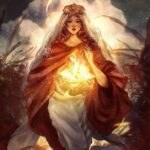 Brigga ap Ítharnae of the Áes Camáir is the goddess of fire, poetry, the hearth, health, fertility, and motherhood. Her Feast Day is in midwinter, which all Sonaide Bri observe by placing lighted candles in the windows of their homes. But most families also keep a special white candle carved with runes honoring Brigga that is lighted in times of need, usually to heal someone in the home who is gravely ill or by women hoping to become pregnant. She is the third of Camáir’s five children. The Festival of Brigga ap Ítharnae, called Fayluh Brigga, is a midwinter festival sometimes called the Festival of Lights or the Festival of Candles. It begins at sundown on Chryadaans 15, the 46th day of the Common Calendar year, and continues into the evening of Chryadaans 16. Children with Ordae Ruíri: Imbas Dúil. Children with Arúyn: Síabrad. Domains: Arcana, Light, Life, Forge, Peace, Grave, Twilight
Brigga ap Ítharnae of the Áes Camáir is the goddess of fire, poetry, the hearth, health, fertility, and motherhood. Her Feast Day is in midwinter, which all Sonaide Bri observe by placing lighted candles in the windows of their homes. But most families also keep a special white candle carved with runes honoring Brigga that is lighted in times of need, usually to heal someone in the home who is gravely ill or by women hoping to become pregnant. She is the third of Camáir’s five children. The Festival of Brigga ap Ítharnae, called Fayluh Brigga, is a midwinter festival sometimes called the Festival of Lights or the Festival of Candles. It begins at sundown on Chryadaans 15, the 46th day of the Common Calendar year, and continues into the evening of Chryadaans 16. Children with Ordae Ruíri: Imbas Dúil. Children with Arúyn: Síabrad. Domains: Arcana, Light, Life, Forge, Peace, Grave, Twilight
 Déine ap Gáeth, the Snow Queen of the Áes Camáir is the goddess of winter and storms. She lives on remote, snow-capped mountain peaks in a palace made of ice that is shrouded in perpetual fog. She is generally depicted with white hair and pale skin, dressed in garments that are silver and white with ice-blue accents. Though she is sometimes shown clad in all-white furs, she is more often shown wearing light clothing more appropriate for the summer for someone not immune to the cold as she is. She is seen as aloof and though certainly not evil, at least somewhat indifferent to the effects of harsh winters. She is accompanied by Nathairsioc, a draconic spirit of wind and ice who is about the size of a large cat. She is the fourth of Camáir’s five children. The Festival of Déine ap Gáeth, or Fayluh Déine, begins on the Winter Solstice. In the Common Calendar, it also now marks the beginning of the new year. Children with Lir ap Tríath: Bráenna ap Túirenn. Children of Ordae Ruíri: Airgdide Gérat, the Silver Knight. Demigod children of the elemental forces of air: Anair ap Gáeth, the East Wind; Faitse ap Gáeth, the South Wind; Íarus ap Gáeth, the West Wind; and Túaiscert ap Gáeth, the North Wind. Her sons, considered demigods, serve as the messengers of the gods and, occasionally, as liaisons between the gods and mortals. Domains: Tempest, Grave, Twilight. Alternate Domain: Ice
Déine ap Gáeth, the Snow Queen of the Áes Camáir is the goddess of winter and storms. She lives on remote, snow-capped mountain peaks in a palace made of ice that is shrouded in perpetual fog. She is generally depicted with white hair and pale skin, dressed in garments that are silver and white with ice-blue accents. Though she is sometimes shown clad in all-white furs, she is more often shown wearing light clothing more appropriate for the summer for someone not immune to the cold as she is. She is seen as aloof and though certainly not evil, at least somewhat indifferent to the effects of harsh winters. She is accompanied by Nathairsioc, a draconic spirit of wind and ice who is about the size of a large cat. She is the fourth of Camáir’s five children. The Festival of Déine ap Gáeth, or Fayluh Déine, begins on the Winter Solstice. In the Common Calendar, it also now marks the beginning of the new year. Children with Lir ap Tríath: Bráenna ap Túirenn. Children of Ordae Ruíri: Airgdide Gérat, the Silver Knight. Demigod children of the elemental forces of air: Anair ap Gáeth, the East Wind; Faitse ap Gáeth, the South Wind; Íarus ap Gáeth, the West Wind; and Túaiscert ap Gáeth, the North Wind. Her sons, considered demigods, serve as the messengers of the gods and, occasionally, as liaisons between the gods and mortals. Domains: Tempest, Grave, Twilight. Alternate Domain: Ice
Arúyn, the Master of the Wild Hunt
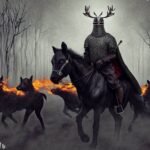 Arúyn, the Master of the Hunt of the Áes Camáir is the god of war, untimely (and especially violent) death, and the underworld. He dresses in dull gray chainmail with a black cloak, and wears a helm with a stag’s antlers. On nights during the dark of the moon, Arúyn leads the the Wild Hunt through the lands with a pack of a dozen hellhounds pulling at their leashes. During these hunts, Arúyn will either ride a Nightmare or run on foot, keeping up with the hounds effortlessly. During the hunt, he hunts the souls of those who lived corrupt, treacherous lives in order to hunt them to their own violent end. In the process, he sometimes collects the souls of those who have died violent, untimely deaths, for the trauma of their deaths can signal his hounds unless the soul is protected by the blessings from loved ones. Sometimes innocent bystanders may also get swept into the hunt if they don’t succeed in avoiding it, magically compelled to join and run with the hunt until dawn. Arúyn is the youngest of Camáir’s five children. The Festival of Arúyn, or Faylon Arúyn, is celebrated as the nights begin to get longer. It begins at sunset on Chelydaans 15th and continues into the evening of Chelydaans 16. Children with Brigga ap Ítharnae: Síabrad. Domains: War, Death
Arúyn, the Master of the Hunt of the Áes Camáir is the god of war, untimely (and especially violent) death, and the underworld. He dresses in dull gray chainmail with a black cloak, and wears a helm with a stag’s antlers. On nights during the dark of the moon, Arúyn leads the the Wild Hunt through the lands with a pack of a dozen hellhounds pulling at their leashes. During these hunts, Arúyn will either ride a Nightmare or run on foot, keeping up with the hounds effortlessly. During the hunt, he hunts the souls of those who lived corrupt, treacherous lives in order to hunt them to their own violent end. In the process, he sometimes collects the souls of those who have died violent, untimely deaths, for the trauma of their deaths can signal his hounds unless the soul is protected by the blessings from loved ones. Sometimes innocent bystanders may also get swept into the hunt if they don’t succeed in avoiding it, magically compelled to join and run with the hunt until dawn. Arúyn is the youngest of Camáir’s five children. The Festival of Arúyn, or Faylon Arúyn, is celebrated as the nights begin to get longer. It begins at sunset on Chelydaans 15th and continues into the evening of Chelydaans 16. Children with Brigga ap Ítharnae: Síabrad. Domains: War, Death
Descendants of the Children of Camáir
Airgdide Gérat, the Silver Knight
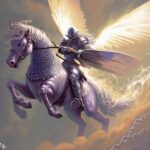 Airgdide Gérat, the Silver Knight of the Áes Camáir is the god of battle, heroism, and chivalry. The Silver Knight appears dressed in chain mail, gauntlets, helm, and shield all of highly polished silver. His hair and light beard is golden blond, light enough to almost be white. He rides a flying pegasus named Lúamain and wields a spear and a great sword that are both able to deal electrical damage. In battle, he is accompanied by a retinue of knights similarly attired and mounted, and it is said that on stormy nights that the lightning comes from their heavenly battles. Parents: Ordae Ruíri, the Golden King (father), and Déine ap Gáeth, the Snow Queen (mother). Children with Énchendach ap Fidbaid: Gentraige Fín. Domains: War, Tempest, Light, Order, Grave, Peace, Twilight
Airgdide Gérat, the Silver Knight of the Áes Camáir is the god of battle, heroism, and chivalry. The Silver Knight appears dressed in chain mail, gauntlets, helm, and shield all of highly polished silver. His hair and light beard is golden blond, light enough to almost be white. He rides a flying pegasus named Lúamain and wields a spear and a great sword that are both able to deal electrical damage. In battle, he is accompanied by a retinue of knights similarly attired and mounted, and it is said that on stormy nights that the lightning comes from their heavenly battles. Parents: Ordae Ruíri, the Golden King (father), and Déine ap Gáeth, the Snow Queen (mother). Children with Énchendach ap Fidbaid: Gentraige Fín. Domains: War, Tempest, Light, Order, Grave, Peace, Twilight
 Bráenna ap Túirenn of the Áes Camáir is the goddess of fresh water (such as rain, rivers, and lakes), agriculture, and healing. Parents: Lir ap Tríath (father) and Déine ap Gáeth (mother). The Festival of Bráenna ap Túirenn, or Fayluh Bráenna, is a midspring festival that is sometimes called Bonfire Day. It begins at sundown on Pausadaans 15 and continues into the next evening. Domains: Life, Nature
Bráenna ap Túirenn of the Áes Camáir is the goddess of fresh water (such as rain, rivers, and lakes), agriculture, and healing. Parents: Lir ap Tríath (father) and Déine ap Gáeth (mother). The Festival of Bráenna ap Túirenn, or Fayluh Bráenna, is a midspring festival that is sometimes called Bonfire Day. It begins at sundown on Pausadaans 15 and continues into the next evening. Domains: Life, Nature
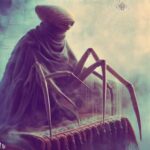 Damán Allaid, the Weaver of the Áes Camáir is the goddess of prophesy, destiny, and the interconnectedness of events, as well as death in its proper course. She is generally depicted seated at a loom shrouded in a dark gray cloak that conceals that she is essentially a large, anthropomorphized spider, generally with a woman’s face and torso and eight limbs. In her tapestries she weaves scenes of great historical events that have not yet happened, though it is said that the depictions are often cryptic and sometimes misinterpreted by those who see them. While Arúyn is seen as the patron of violent and untimely death, the Weaver is seen as the patron of death in its own time, particularly of old age. Parents: Ordae Ruíri (father) and Rígan Lúan (Áes Camáir goddess) (mother). Domains: Arcana, Knowledge, Life, Death, Order, Grave, Twilight
Damán Allaid, the Weaver of the Áes Camáir is the goddess of prophesy, destiny, and the interconnectedness of events, as well as death in its proper course. She is generally depicted seated at a loom shrouded in a dark gray cloak that conceals that she is essentially a large, anthropomorphized spider, generally with a woman’s face and torso and eight limbs. In her tapestries she weaves scenes of great historical events that have not yet happened, though it is said that the depictions are often cryptic and sometimes misinterpreted by those who see them. While Arúyn is seen as the patron of violent and untimely death, the Weaver is seen as the patron of death in its own time, particularly of old age. Parents: Ordae Ruíri (father) and Rígan Lúan (Áes Camáir goddess) (mother). Domains: Arcana, Knowledge, Life, Death, Order, Grave, Twilight
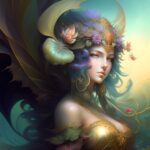 Énchendach ap Fidbaid of the Áes Camáir is the goddess of nature. She is depicted as a young maiden dressed in feathers and foliage. There are numerous tales in which travelers find a seemingly vulnerable maiden wandering in the woods, only to find that she’s far from helpless when bandits suddenly attack. She is generally depicted as good, but chaotic and capricious. The Festival of Énchendach ap Fidbaid, or Faylon Énchendach, is the Spring Equinox on the Common Calendar. The celebration begins at sundown on Melquedaans 30 and continues into the evening of Bennedaans 1. Parents: Lir ap Tríath (father) and Rígan Lúan (mother). Children with Airgdide Gérat: Gentraige Fín. Domains: Nature, Trickery, Grave, Twilight
Énchendach ap Fidbaid of the Áes Camáir is the goddess of nature. She is depicted as a young maiden dressed in feathers and foliage. There are numerous tales in which travelers find a seemingly vulnerable maiden wandering in the woods, only to find that she’s far from helpless when bandits suddenly attack. She is generally depicted as good, but chaotic and capricious. The Festival of Énchendach ap Fidbaid, or Faylon Énchendach, is the Spring Equinox on the Common Calendar. The celebration begins at sundown on Melquedaans 30 and continues into the evening of Bennedaans 1. Parents: Lir ap Tríath (father) and Rígan Lúan (mother). Children with Airgdide Gérat: Gentraige Fín. Domains: Nature, Trickery, Grave, Twilight
 Gentraige Fín of the Áes Camáir is the god of wine, love, music, and the arts. He is depicted as young man in his late teens to early twenties, carefree and lighthearted, and a bit hedonistic. He is shown as sexually adventurous and voracious, the patron of both lust and of young love. The notes of his music are carried by the winds to cause young people to fall in love. The Festival of Gentraige Fín, or Fayluh Gentraige, is a celebration of the Autumn Equinox on the Common Calendar, beginning at sundown on Ketedaans 30 and continuing into the evening of Garudaans 1. Parents: Airgdide Gérat (father) and Énchendach ap Fidbaid (mother). Domains: Light, Trickery, Grave, Twilight
Gentraige Fín of the Áes Camáir is the god of wine, love, music, and the arts. He is depicted as young man in his late teens to early twenties, carefree and lighthearted, and a bit hedonistic. He is shown as sexually adventurous and voracious, the patron of both lust and of young love. The notes of his music are carried by the winds to cause young people to fall in love. The Festival of Gentraige Fín, or Fayluh Gentraige, is a celebration of the Autumn Equinox on the Common Calendar, beginning at sundown on Ketedaans 30 and continuing into the evening of Garudaans 1. Parents: Airgdide Gérat (father) and Énchendach ap Fidbaid (mother). Domains: Light, Trickery, Grave, Twilight
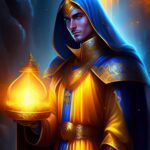 Imbas Dúil of the Áes Camáir is the god of speech, writing, and magical lore, and as such is often favorite by wizards and sorcerers. He is sometimes depicted bearing the Gablán dé Brigga, also called the Rod of Ítharnae, a wizard’s staff that is a powerful artifact belonging to the goddess Brigga ap Ítharnae, his mother. Parents: Ordae Ruíri (father) and Brigga ap Ítharnae (mother). Domain: Arcana, Knowledge, Grave, Twilight
Imbas Dúil of the Áes Camáir is the god of speech, writing, and magical lore, and as such is often favorite by wizards and sorcerers. He is sometimes depicted bearing the Gablán dé Brigga, also called the Rod of Ítharnae, a wizard’s staff that is a powerful artifact belonging to the goddess Brigga ap Ítharnae, his mother. Parents: Ordae Ruíri (father) and Brigga ap Ítharnae (mother). Domain: Arcana, Knowledge, Grave, Twilight
 Síabrad of the Áes Camáir is the goddess of battle, particularly battle lust and combat frenzy. She is depicted as chaotic, reckless, impulsive, and not always good. Parents: Arúyn (father) and Brigga ap Ítharnae (mother). Domains: War, Death
Síabrad of the Áes Camáir is the goddess of battle, particularly battle lust and combat frenzy. She is depicted as chaotic, reckless, impulsive, and not always good. Parents: Arúyn (father) and Brigga ap Ítharnae (mother). Domains: War, Death
Other Gods in the Áes Camáir Pantheon
Rígan Lúan and the Fairy Cavalcade
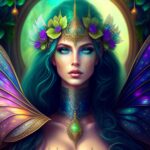 When the Áes Camáir marched forth from the mists, Rígan Lúan met them with an army of pixies and joined with them. After the great battles with the Nephalim, she married Ordae Ruíri, the Golden King, though their relationship is not described as exclusive. She is depicted as pixie-like in appearance with iridescent, rainbow-hued wings, but generally of human size. She often rides forth at the front of the Fairy Cavalcade, a procession of fairies that bring mirth and merriment. For those without the second sight, they are often disguised as a swarm of butterflies or a flock of small songbirds. Once a month on the night of the full moon, she leads the Fairy Cavalcade to collect the souls of those who have died peacefully or in their time, or of good heart, or whom Arúyn has missed or has not had a chance to collect. Children with Ordae Ruíri, the Golden King: Damán Allaid, the Weaver. Children with Lir ap Tríath: Énchendach ap Fidbaid. Domains: Arcana, Life, Light, Nature
When the Áes Camáir marched forth from the mists, Rígan Lúan met them with an army of pixies and joined with them. After the great battles with the Nephalim, she married Ordae Ruíri, the Golden King, though their relationship is not described as exclusive. She is depicted as pixie-like in appearance with iridescent, rainbow-hued wings, but generally of human size. She often rides forth at the front of the Fairy Cavalcade, a procession of fairies that bring mirth and merriment. For those without the second sight, they are often disguised as a swarm of butterflies or a flock of small songbirds. Once a month on the night of the full moon, she leads the Fairy Cavalcade to collect the souls of those who have died peacefully or in their time, or of good heart, or whom Arúyn has missed or has not had a chance to collect. Children with Ordae Ruíri, the Golden King: Damán Allaid, the Weaver. Children with Lir ap Tríath: Énchendach ap Fidbaid. Domains: Arcana, Life, Light, Nature
Demigods
The Four Winds
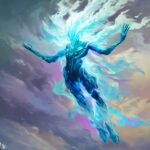 Déine ap Gáeth, the Snow Queen, has four sons born of the elemental forces of air. They are the Four Winds, powerful demigods in their own right, and believed by some to be Elder Tempests or Solars.
Déine ap Gáeth, the Snow Queen, has four sons born of the elemental forces of air. They are the Four Winds, powerful demigods in their own right, and believed by some to be Elder Tempests or Solars.
Some say a powerful being from the Elemental Plane of Air sired the Winds, while others claim that The Féth itself sired them. Though they are quadruplets, it is said that they took up so little space in Déine’s womb that she alone knew she was even pregnant until she delivered them.
Legends describe them as serving as messengers for the gods.
Though their iconography adorns some Áes Camáir temples, they are not worshipped individually and have no priests dedicated to serving them. It is said, though, that there may be some warlocks for whom they serve as Celestial or Djinn patrons.
Anair ap Gáeth, the East Wind, is seen as a bringer of warm rains. He is associated with the summer.
Faitse ap Gáeth, the South Wind
Faitse ap Gáeth, the South Wind, is associated with the desiccating, hot wind of late summer and autumn.
Íarus ap Gáeth, the West Wind, is the most gentle and favorable of the winds. He is associated with flowers, springtime, and procreation. In myths, he is presented as the tender breeze,
Túaiscert ap Gáeth, the North Wind
Túaiscert ap Gáeth is the cold wind from the north. He is associated with storms and winter. He is depicted as being very strong, with a violent temper to match.
Finian ap Cadman
 Finian ap Cadman, is a legendary hero who, generations after the Nephilim & Anakim War Against the Sonaide Bri, defended his community against a few straggler Anakim, earning for himself the title of Giant Slayer. In some legends, he is a descendant of Ordae Ruíri's coupling with a mortal woman. His feats drew the attention of the gods who, on his mortal deathbed, granted him immortality and elevated him to the status of a demigod.
Finian ap Cadman, is a legendary hero who, generations after the Nephilim & Anakim War Against the Sonaide Bri, defended his community against a few straggler Anakim, earning for himself the title of Giant Slayer. In some legends, he is a descendant of Ordae Ruíri's coupling with a mortal woman. His feats drew the attention of the gods who, on his mortal deathbed, granted him immortality and elevated him to the status of a demigod.
Domains of the Áes Camáir
- Arcana – Brigga ap Ítharnae, Damán Allaid; Imbas Dúil; Rígan Lúan
- Death – Arúyn; Damán Allaid, Síabrad
- Forge – Brigga ap Ítharnae
- Grave – Ordae Ruíri, Lir ap Tríath, Brigga ap Ítharnae, Déine ap Gáeth, Airgdide Gérat, Damán Allaid, Énchendach ap Fidbaid, Gentraige Fín, Imbas Dúil
- Knowledge – Damán Allaid; Imbas Dúil
- Life – Bráenna ap Túirenn; Brigga ap Ítharnae; Damán Allaid; Lir ap Tríath; Rígan Lúan
- Light – Airgdide Gérat; Brigga ap Ítharnae; Gentraige Fín; Rígan Lúan
- Nature – Bráenna ap Túirenn; Énchendach ap Fidbaid, Rígan Lúan
- Order – Ordae Ruíri, Airgdide Gérat, Damán Allaid
- Peace – Ordae Ruíri, Brigga ap Ítharnae, Airgdide Gérat
- Tempest – Airgdide Gérat; Déine ap Gáeth; Lir ap Tríath
- Trickery – Énchendach ap Fidbaid; Gentraige Fín
- Twilight – Ordae Ruíri, Lir ap Tríath, Brigga ap Ítharnae, Déine ap Gáeth, Airgdide Gérat, Damán Allaid, Énchendach ap Fidbaid, Gentraige Fín, Imbas Dúil
- War – Airgdide Gérat; Arúyn; Ordae Ruíri; Síabrad
Áes Camáir Artifacts & Relics
The gods of the Áes Camáir bear powerful magical artifacts, and occasionally grant avatars of these relics to favored mortal champions.
Four of these relics, known as the Four Blessings, are the most powerful. Other relics are known as the Lesser Gifts, but they remain more powerful than anything a modern mage could create.
The Four Blessings
The Four Blessings are four powerful artifacts possessed by the Áes Camáir. From time to time, their avatars may also simultaneously exist on the prime material plane. Each is semi-sentient, but communicates cryptically through dreams, visions, and emotional projection rather than vocalized words. Each has a primary form but is also known to manifest in alternate forms as well. The gods will sometimes allow mortals to bear one of the blessings (and, extraordinarily rarely, perhaps two of them, but no one has ever been known to have more than two). The Blessings will only attune to someone of good intent whom the gods approve of, though this need not be someone who worships the Áes Camáir. The gods may grant use of one of the Four Blessings for a time – an individual quest, or an ongoing mission for the gods. Sometimes the Blessing is delivered to the mortal by one of the four winds. Other times, the gods may send dreams and visions to the mortal instructing them on where to find it. But the gods can be capricious, and someone who possesses one of the Blessings may find themselves challenged by a supernatural entity to reprove their worthiness, or it might simply disappear if the possessor has angered the gods or fulfilled their mission.
Once attuned, the relics generally cannot be taken from their possessor except when given away, taken back by the gods, or through death. The attuned possessor can always cause the relic to teleport back to him or herself from any distance, even across planes. Those who possess a relic age much more slowly than usual, though once they no longer possess the relic, they will begin to age normally from that point forth.
 Also called the Blade of Airgdide Gérat, the Fáebar dé Gérat generally manifests as a great sword whose silver blade crackles with a blue-white electrical energy. It may also manifest as a spear, an arrow, or other piercing weapon. It is associated with the god Airgdide Gérat, the element of air, and the east wind Anair ap Gáeth. For its authorized bearer, it confers the power of flight, whether held or sheathed. Wielders are automatically immune to lightning and electrical-based damage, whether from the weather, spell, breath weapons, or other sources, and the blade also grants the bearer the ability to cast certain lightning-based spells.
Also called the Blade of Airgdide Gérat, the Fáebar dé Gérat generally manifests as a great sword whose silver blade crackles with a blue-white electrical energy. It may also manifest as a spear, an arrow, or other piercing weapon. It is associated with the god Airgdide Gérat, the element of air, and the east wind Anair ap Gáeth. For its authorized bearer, it confers the power of flight, whether held or sheathed. Wielders are automatically immune to lightning and electrical-based damage, whether from the weather, spell, breath weapons, or other sources, and the blade also grants the bearer the ability to cast certain lightning-based spells.
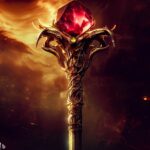 The Gablán dé Brigga, sometimes called the Rod of Ítharnae, belongs to the goddess Brigga ap Ítharnae but is often depicted being wielded by her son, Imbas Dúil. It generally manifests as a wizard’s staff but may also appear from time to time as a scepter, a wand, a shepherd’s crook, or similar rod-like object. It is associated with the element of fire and the south wind Faitse ap Gáeth. Those who wield it are granted immunity to all fire-based damage, including magical fire, dragon’s breath, and supernatural flames like on the Elemental Plane of Fire.
The Gablán dé Brigga, sometimes called the Rod of Ítharnae, belongs to the goddess Brigga ap Ítharnae but is often depicted being wielded by her son, Imbas Dúil. It generally manifests as a wizard’s staff but may also appear from time to time as a scepter, a wand, a shepherd’s crook, or similar rod-like object. It is associated with the element of fire and the south wind Faitse ap Gáeth. Those who wield it are granted immunity to all fire-based damage, including magical fire, dragon’s breath, and supernatural flames like on the Elemental Plane of Fire.
 The Croccán dé Túirenn generally appears as a cauldron but can also manifest as a chalice, grail, or similar vessel for liquids. It is primarily associated with the goddess Bráenna ap Túirenn, but also with Íarus ap Gáeth, the west wind. The person attuned to the cauldron can ladle from it an unlimited amount of hearty stew or water. In addition, they can use the cauldron to instantly create potions that heal injuries, cure diseases, neutralize poisons, and grant vitality. It is said that mages who use the cauldron to brew other potions can do so faster and with a reduced cost.
The Croccán dé Túirenn generally appears as a cauldron but can also manifest as a chalice, grail, or similar vessel for liquids. It is primarily associated with the goddess Bráenna ap Túirenn, but also with Íarus ap Gáeth, the west wind. The person attuned to the cauldron can ladle from it an unlimited amount of hearty stew or water. In addition, they can use the cauldron to instantly create potions that heal injuries, cure diseases, neutralize poisons, and grant vitality. It is said that mages who use the cauldron to brew other potions can do so faster and with a reduced cost.
 Ordae Ruíri wears a great golden crown known as the Lía dé Ordae. It can take the same form on the prime material plane but can also manifest as a helmet, hat, circlet, or other head covering. It is associated with the element of earth and the north wind, Túaiscert ap Gáeth. It is said to grant the wearer immunity from being charmed, petrified, poisoned, or magically frightened, and also grants heightened resistance to hostile enchantments. The crown also grants the bearer the ability to communicate in any tongue, and improves their insight, perception, and persuasiveness. While wearing the crown, the bearer is able to scry across great distances.
Ordae Ruíri wears a great golden crown known as the Lía dé Ordae. It can take the same form on the prime material plane but can also manifest as a helmet, hat, circlet, or other head covering. It is associated with the element of earth and the north wind, Túaiscert ap Gáeth. It is said to grant the wearer immunity from being charmed, petrified, poisoned, or magically frightened, and also grants heightened resistance to hostile enchantments. The crown also grants the bearer the ability to communicate in any tongue, and improves their insight, perception, and persuasiveness. While wearing the crown, the bearer is able to scry across great distances.
The Lesser Gifts
The Lesser Gifts are Áes Camáir artifacts that while not as powerful as the Four Blessings are nevertheless very mighty indeed.
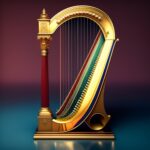 The Óirlúit generally appears as a golden harp, though it may appear as any musical instrument desired. Though not one of the Four Blessings, it is a very powerful relic in its own right, particularly when used by bards. Though it is not specifically named after him, many legends depict it being used by Gentraige Fín or delivered to a worthy mortal by him. Its strings cannot break, and it is said when a bard uses it to weave a spell, their spells are more powerful and more abundant. Some legends depict it as being used by Gwytheon, the mythical composer of the The Ádairiad sagas.
The Óirlúit generally appears as a golden harp, though it may appear as any musical instrument desired. Though not one of the Four Blessings, it is a very powerful relic in its own right, particularly when used by bards. Though it is not specifically named after him, many legends depict it being used by Gentraige Fín or delivered to a worthy mortal by him. Its strings cannot break, and it is said when a bard uses it to weave a spell, their spells are more powerful and more abundant. Some legends depict it as being used by Gwytheon, the mythical composer of the The Ádairiad sagas.
 The Seodaghrian is a fist-sized crystal that floats about the bearer when it is not hidden or being carried. It emits a bright light unless commanded not to, granting the bearer improved perceptiveness as well as the ability to see magic and sometimes pierce through illusions and magical disguises. It is not associated with any of the gods in particular, and unlike the other Áes Camáir relics, it is believed that it need not be granted by the grace of the gods but rather can be found by happenstance. Some believe that there may be more than one.
The Seodaghrian is a fist-sized crystal that floats about the bearer when it is not hidden or being carried. It emits a bright light unless commanded not to, granting the bearer improved perceptiveness as well as the ability to see magic and sometimes pierce through illusions and magical disguises. It is not associated with any of the gods in particular, and unlike the other Áes Camáir relics, it is believed that it need not be granted by the grace of the gods but rather can be found by happenstance. Some believe that there may be more than one.
Sonaide Bri Beliefs and Traditions
Death and the Afterlife
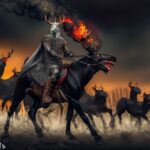 The people of the Sonaide Bri believe that upon death, their spirits continue to wander the earth for a brief time to bid farewell to their loved ones. Those spirits will then be collected to pass into their home in the Afterlife.
The people of the Sonaide Bri believe that upon death, their spirits continue to wander the earth for a brief time to bid farewell to their loved ones. Those spirits will then be collected to pass into their home in the Afterlife.
Those who were wicked and cruel in life may find themselves targeted by the the Wild Hunt during the dark of the moon, where their spirits will be brutally mauled by Arúyn's pack of wolves before being dragged to Arúyn's home in the underworld. In the process, other souls who should be not condemned may also be inadvertently swept up to join the hunt, doomed to reside with Arúyn in the underworld unless the prayers of their loved ones can cause the Hunt to pass them by. This is particularly true for souls who died in violence, such as murder victims and the victims of catastrophic disasters, as the trauma of their untimely death can confuse the Hunt into believing they are marked by evil and a target of their hunt. For that reason, the Sonaide Bri pray to bless their loved ones when they pass and shield them from the Hunt, especially if they pass after the new moon but before the dark of the moon.
This is not true for warriors who die in battle, however. Those warriors are blessed by Airgdide Gérat himself and are protected from inadvertently being swept up by the Hunt unless their wicked life would already make them a direct target of the Hunt. In addition, a few great heroes may be personally selected by Airgdide Gérat to join his retinue of knights in the Afterlife.
But for most of the dead, they spend some time as a spirit visiting their loved ones and saying their farewells before they are collected by Rígan Lúan and the Fairy Cavalcade during the light of the full moon, where they will be brought to Ordae Ruíri's palace in the Feywild or to Rígan Lúan's sylvan groves.
Holidays and Festivals
 The Sonaide Bri celebrate eight major holidays that correspond with the summer and winter solstices, the spring and autumn equinoxes, and the midpoints between each. Each one is a special feast day for one of the Áes Camáir gods.
The Sonaide Bri celebrate eight major holidays that correspond with the summer and winter solstices, the spring and autumn equinoxes, and the midpoints between each. Each one is a special feast day for one of the Áes Camáir gods.
The festivals begin at sundown and continue through the evening of the next day.
Fayluh Brigga
The Festival of Brigga ap Ítharnae, called Fayluh Brigga, is a midwinter festival sometimes called the Festival of Lights or the Festival of Candles. It begins at sundown on Chryadaans 15, the 46th day of the Common Calendar year, and continues into the evening of Chryadaans 16. The Sonaide Bri celebrate it by lighting candles or lanterns in prominent windows, or sometimes on the front porch or elsewhere in front of the home. It is a feast day marked by hearty fare, when possible.
Faylon Énchendach
The Festival of Énchendach ap Fidbaid, or Faylon Énchendach, is the Spring Equinox on the Common Calendar. The celebration begins at sundown on Melquedaans 30 and continues into the evening of Bennedaans 1. Homes are decorated with real flowers if they are available, or artificial ones made of colored paper, glass, or ceramic.
Fayluh Bráenna
The Festival of Bráenna ap Túirenn, or Fayluh Bráenna, is a midspring festival that is sometimes called Bonfire Day. It begins at sundown on Pausadaans 15 and continues into the next evening. The Sonaide Bri celebrate with public and private bonfires that celebrants dance about. For some, it is a lustful celebration, and outdoor assignations are common.
Fayluh Lir
The Festival of Lir ap Tríath, or Fayluh Lir, is celebrated on the Summer Solstice on the Common Calendar, beginning at sundown on Altadaans 31 and continuing into the evening of Tuthodaans 1.
Faylon Ordae
The Festival of Ordae Ruíri, or Faylon Ordae, begins at sundown on Meludaans 15th and continues into the next evening. It is a midsummer celebration and one of the most important on the Sonaide Bri calendar. It is typically celebrated with fruit, both cooked with savory spices as part of meals as well as in pies and confections for dessert.
Fayluh Gentraige
The Festival of Gentraige Fín, or Fayluh Gentraige, is a celebration of the Autumn Equinox on the Common Calendar, beginning at sundown on Ketedaans 30 and continuing into the evening of Garudaans 1. It is celebrated with a harvest feast.
Faylon Arúyn
The Festival of Arúyn, or Faylon Arúyn, is celebrated as the nights begin to get longer. It begins at sunset on Chelydaans 15th and continues into the evening of Chelydaans 16. The ancient Sonaide Bri considered it to be the start of their new year, a day when the walls between the living and the afterlife were thinnest. Though modern Sonaide Bri have adopted the Common Calendar, this remains an important holiday, for it is believed that the the Wild Hunt is fiercest on this day. Youngsters celebrate with spooky costumes and parades meant to simulate the Wild Hunt, while the most devout observe with prayers to protect the spirits of the recent dead, that they may be safe from the Hunt.
Fayluh Déine
The Festival of Déine ap Gáeth, or Fayluh Déine, begins on the Winter Solstice. In the Common Calendar, it also now marks the beginning of the new year. It is a gift-giving holiday among the Sonaide Bri. Servants are generally given the day off. Those who must work usually have their hours shortened, when possible, and are granted generous compensation and extra leave thereafter.
Heroes & Legends
 In Áes Camáir folklore, there are a number of humans who upon their deaths were elevated to demigod status. Some of these heroes claimed in life to be a child of an Áes Camáir god who copulated with a mortal human, or a lineal descendent of such a union. Others were born fully human and mortal, but were elevated by the grace of the gods in recognition of their great deeds in life. None of them grant divine spells to their clerics or priests. Rather, like a saint, they are prayed to as potential intermediaries who might intervene on their behalf with the other gods.
In Áes Camáir folklore, there are a number of humans who upon their deaths were elevated to demigod status. Some of these heroes claimed in life to be a child of an Áes Camáir god who copulated with a mortal human, or a lineal descendent of such a union. Others were born fully human and mortal, but were elevated by the grace of the gods in recognition of their great deeds in life. None of them grant divine spells to their clerics or priests. Rather, like a saint, they are prayed to as potential intermediaries who might intervene on their behalf with the other gods.
- Finian ap Cadman – Warrior figure known as the Giant Slayer
- Mother Una – In the early years of the Goblin Wars, before Ádair ap Uedán ascended to the throne, Mother Una saved her people during the Siege of the High Reaches
- Ádair ap Uedán – Baseborn lad chosen by the gods to unite the Sonaide Bri and serve as their High King.
- Myogan, the Kestrel – A great wizard who served as advisor to King Ádair.
- Twyndír Amhrání – Legendary princess, younger daughter of a king who was making her marry a foreign lord. Despondent, she considered drowning herself in a pond. The fairy queen Rígan Lúan took pity on Twyndír and turned her into a songbird. As a bird, Twyndír joined the Fairy Cavalcade and in time was made into a fairy herself.
The Ádairiad
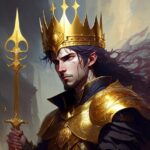 The Ádairiad is a collection of epic poems in Áes Camáir folklore penned by an ancient bard, Gwytheon. It tells a series of tales about Ádair ap Uedán, a baseborn lad chosen by the gods to unite the Sonaide Bri against goblin invaders. Once the goblins were beaten back, Ádair built a great castle called Trevena where he reigned until the palace was destroyed by a powerful demon named Baylígûr.
The Ádairiad is a collection of epic poems in Áes Camáir folklore penned by an ancient bard, Gwytheon. It tells a series of tales about Ádair ap Uedán, a baseborn lad chosen by the gods to unite the Sonaide Bri against goblin invaders. Once the goblins were beaten back, Ádair built a great castle called Trevena where he reigned until the palace was destroyed by a powerful demon named Baylígûr.
The major figures in The Ádairiad include:
- Mother Una – In the early years of the Goblin Wars, before Ádair ap Uedán ascended to the throne, Mother Una saved her people during the Siege of the High Reaches
- Ádair ap Uedán – Baseborn lad chosen by the gods to unite the Sonaide Bri and serve as their High King. After the goblin wars, he built the greatest palace ever known, Trevena, which was later destroyed by Myogan in an effort to destroy Baylígûr, a powerful demon inadvertently brought from the outer realms.
- Queen Whenfara – Wife of King Ádair. Tragically, all of her babies were stillborn until a final set of twins was born mere months before Trevena was destroyed.
- Myogan, the Kestrel – A great wizard who served as advisor to King Ádair
- Gwytheon – Bard figure to whom many of the oldest ballads about King Ádair are attributed. A collection of ballads about King Ádair, collectively called The Ádairiad, are believed to have been written by Gwytheon.
- Lafáil Ravenwyrd – Dark and powerful sorceress who appears in some legends of King Ádair. Some also conflate her with the Raven Queen of the Shadar-kai.
- Numaria – Female apprentice of Myogan who later inadvertently summoned Baylígûr, a powerful demon who brought down Trevena.
- Baylígûr – Powerful demon or devil whom Numaria was tricked by Lafáil Ravenwyrd into summoning in the final days of Trevena.
Ansel Feirmeoir’s Escape from the Wild Hunt
 Long ago in the time of legends, according to Áes Camáir folklore, Ansel Feirmeoir was a young farmer who was about as average and ordinary as one could be. One day, he saw something fluttering in a briar bush. Taking it for a small bird, he went to rescue it, only to discover that it was a tiny pixie. She kissed him on the forehead before disappearing, leaving behind a slight glow that soon faded.
Long ago in the time of legends, according to Áes Camáir folklore, Ansel Feirmeoir was a young farmer who was about as average and ordinary as one could be. One day, he saw something fluttering in a briar bush. Taking it for a small bird, he went to rescue it, only to discover that it was a tiny pixie. She kissed him on the forehead before disappearing, leaving behind a slight glow that soon faded.
Thereafter, Ansel was gifted with extraordinary luck. At night, he could always pick out the correct path home even when the clouds blocked the moonlight. When dicing with his friends or playing cards, he always chanced to win just enough to come out ahead, but not so much that his friends wouldn’t play against him anymore, especially when he bought rounds of ale with his winnings. When a potato blight struck one year, he happened to have switched to growing turnips and carrots that season. When all the lads started to woo the miller’s daughter, it was Ansel she chose to be her husband. And when she gave birth to three healthy children over the next decade, the midwives all said they had never aided with such easy childbirths.
Many years later, when Ansel was now a grandfather, he was visiting an ailing friend two towns over. He lingered with his friend, and it was therefore much later than he planned when he finally set off for home. Though there was no moon out that night, he could still make out the path easy enough. Then suddenly he heard a terrible howling in the distance. Across a meadow, he saw a man with an antlered helm riding a black warhorse. The man was surrounded by black mastiffs that belched fire, and they had picked up his scent. It was the the Wild Hunt, and they meant to take him with them.
Terrified, Ansel meant to flee, but his legs were as if turned to pudding. The Hunt was so close he could smell their sulfuric breath when suddenly a glowing light appeared. It was the fairy again, the same one he had rescued so many years earlier when he was just a young man. The fairy kissed him on the forehead in the same spot when she had kissed him when he had rescued her. He blinked and found himself safe on his own doorstep, far from the danger of the Wild Hunt.
Thereafter, his uncommonly good luck disappeared. He was now no more likely to win at dice or cards than anyone else. When the occasional blights came, his farm was affected with everyone else’s. And at night, he had as much trouble as anyone in finding the path home. But though his special luck was gone, it had served him when he needed it most, protecting Ansel from the Wild Hunt.
Twyndír Amhrání and the Fairy Queen
 Twyndír Amhrání was a legendary princess long ago in Áes Camáir folklore. She was the younger daughter of a king who had pledged her hand in marriage to a foreign lord. Despondent, she considered drowning herself in a pond. The fairy queen Rígan Lúan took pity on Twyndír and turned her into a songbird. As a bird, Twyndír joined the Fairy Cavalcade and in time was made into a fairy herself.
Twyndír Amhrání was a legendary princess long ago in Áes Camáir folklore. She was the younger daughter of a king who had pledged her hand in marriage to a foreign lord. Despondent, she considered drowning herself in a pond. The fairy queen Rígan Lúan took pity on Twyndír and turned her into a songbird. As a bird, Twyndír joined the Fairy Cavalcade and in time was made into a fairy herself.

